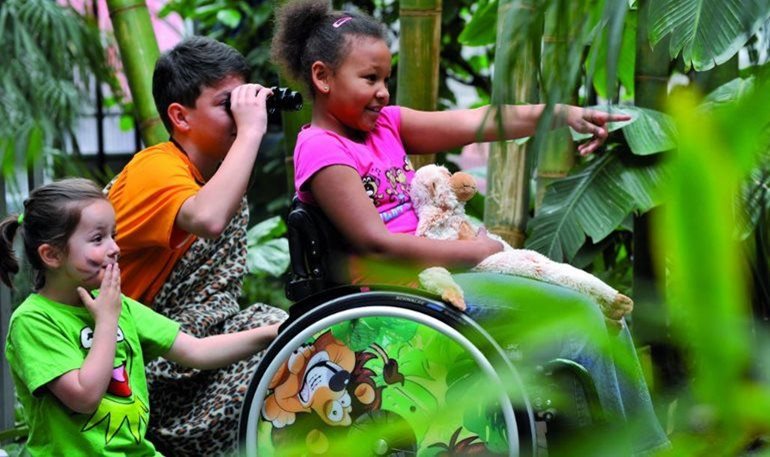Share:
Take it offline!
This Education in Motion resource is also available as a printable PDF.
Download PDF
Playing is a fundamental part of a child’s life. In addition to being enjoyable, it is a necessary element of learning. In the case of children with disabilities, adapted toys are a particularly important resource that helps build self-esteem, fostering the development of the child’s capabilities.
Why are adapted toys for children with disabilities necessary?
In 1959, the United Nations General Assembly recognized play as one of the rights of the child. Playing enables children to understand the world around them, to learn to relate to others, and to experiment with their potential, facilitating growth and development.
Yet, without adequate tools, playing can be a challenge. Many children with disabilities do not have access to toys adapted to their needs. Providing these children with adapted toys that comply with specific criteria is essential for creating an accessible society, in which all of the children, with or without disabilities, can share toys and playtime in ways that ensure equal opportunities and effective integration.
At the same time, by producing toys for children with special needs, manufacturers make a constructive and progressive commitment to building a truly accessible society.

What are adapted toys?
Adapted toys are those that have been physically modified to make them suitable to use by children with disabilities. Some of these changes are simple, such as adding velcro strap in order to keep toys from slipping; others are more complex, such as translating visual and sound effects, which is a widely used adaptation in educational toys for children with special needs.
Because of the great variety of types and degrees of disability that exist, establishing general guidelines for adapting toys for children with disabilities is a complicated task; however, all of them must follow the following basic criteria:
- Design that works for everyone. Any child should be able to use these toys, minimizing the difference between adapted and non-adapted toys.
- Versatility. They allow for various types of interactions, so that a toy can adapt to the needs of any child.
- Flexibility. Toys for children with disabilities adapt to any age, in accordance with each child’s pace of learning.
- Safety. Adapted toys must comply with all safety norms that apply to toy manufacturing.
Types of adapted toys
There are various types of adapted toys since different children benefit from different kinds of toys. Here are the most common:
- Toys for exercise: basically, they encourage the child to repeat an action multiple times.
- Symbolic toys: toys that imply that one object represents another.
- Building toys: toys that have pieces that fit inside one another, overlap, stack, etc.
- Rule-based games: games that include instructions or norms that players must follow.
- Educational games: these games deserve a special mention because, in addition to facilitating enjoyable leisure, they constitute an important educational resource.
When creating adapted toys it is important to pay attention to the type of disability, whether it is visual, auditory or motor, since it will drive the way in which toys are used. The most common adapted toys are:
- Those with remote controls and switches that let children move and operate a toy independently.
- Computer peripherals, the use of which turns a computer into a tool for recreation and learning.

A few examples of simple adapted toys
Adapting toys for children with disabilities is not difficult, but this is what you have to keep in mind:
- Type of disability
- Age
- Needs of the child
In case of the toys for those with physical disabilities and motor challenges, the main objective is to help children overcome physical barriers with toys that support handling everyday activities. Adaptations for disabilities of this kind would be:
- Fitting the toys’ bottom surfaces with Velcro or clamps to keep them from sliding during play.
- Making parts and handles larger to facilitate manipulation.
- Adding pull ropes or rods to make dragging some toys easier.
- Changing part dimensions to simplify their handling, or incorporating such elements as pegs, rings or levers to make it easier for children to pick them up.
Sounds, relief and textures will be particularly important for children with visual impairment:
- Board games must include Braille translations of instructions.
- Indicators or illustrations should be in relief.
- Adaptation can be enhanced by adding voice recordings to replace textual information.
When adapting toys for children with hearing impairment,
- Provide transcripts of all recorded messages.
- Include electronic devices that translate sound effects into other types of effects, which the child would be able to perceive, such as vibrations that vary according to the sounds emitted by the toy.
At Sunrise Medical, we also care about the younger ones. Discover our line of products for children. In addition, you can read about related topics on our blog. Subscribe and receive monthly updates. We look forward to seeing you!